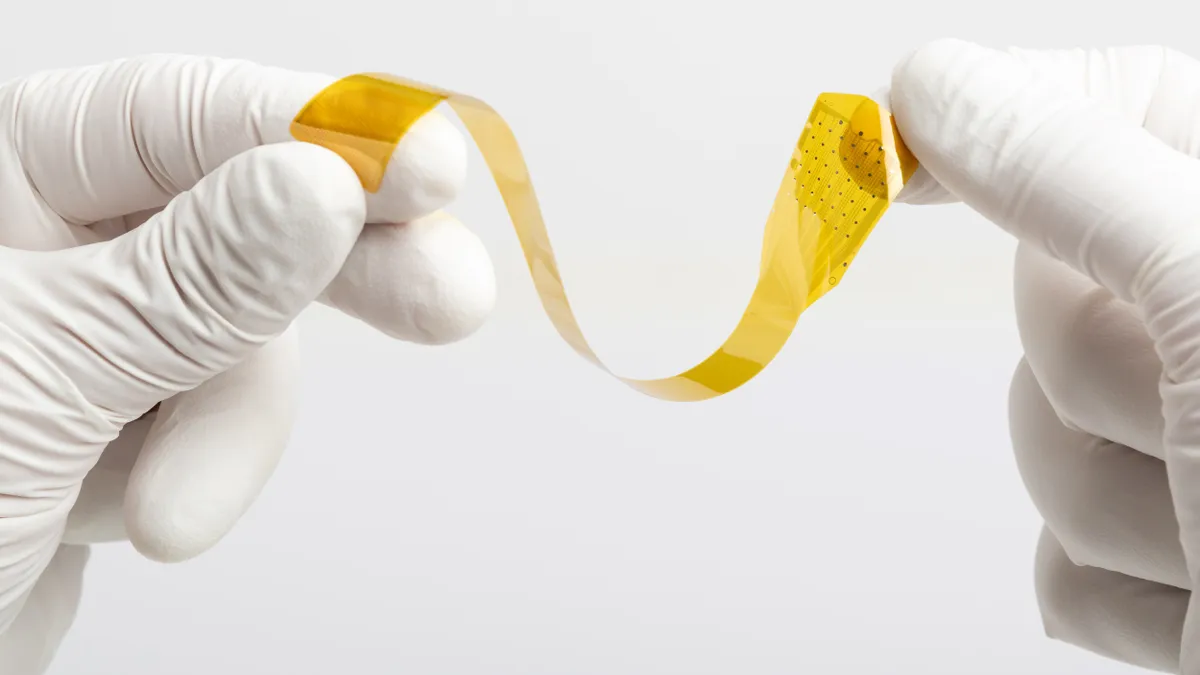Once used primarily to treat failed back surgery syndrome, neuromodulation today crosses therapeutic indications by targeting nerve activity central to diseases like Parkinson's, Alzheimer's and epilepsy, as well as peripheral pain, urinary and fecal incontinence and depression.
The devices use implanted or externally-placed electrodes to stimulate a patient's spinal cord, brain or peripheral nerves, blocking pain signals or prompting neural impulses.
Particularly amid national efforts to tamp down on widespread opioid abuse, proponents of neuromodulation say devices can offer an alternative to addictive and often ineffective pain medications. Also driving momentum are a growing elderly population, rising incidence of neurological diseases and robust research into new indications for the technology, like obstructive sleep apnea and heart failure.
Still, neuromodulators face some barriers to consumer uptake and trust. Categories like electroconvulsive therapy can be negatively connoted as 'shock therapy' for already stigmatized mental health conditions, and a 2016 literature review found adverse events for devices like spinal cord stimulators were reported at a rate of 30% to 40% among users.
Also, implantable systems are invasive by nature and can cost upwards of $20,000, with varying levels of payer coverage.
But that isn't stopping growth, with the global implantable neuromodulation market expected to reach $10.9 billion by 2028, rising from $4.7 billion in 2018, according to U.K. data and analytics company GlobalData.
Getting beyond pain
The largest and fastest-growing market for neuromodulation is chronic pain, GlobalData analyst Hanuel Park told MedTech Dive.
"We generally look for beyond 50% improvement in somebody's overall pain score," as well as gains in quality of life, says Sean Nagel, a neurosurgeon with Cleveland Clinic who focuses on brain and spine implants.
That growth is due not just to anti-opioid pressures, but because device offerings have evolved beyond just deep brain stimulation (DBS) systems, which involve a pacemaker-like device implanted in the chest, connected by a wire to electrodes inside the brain.
While there's correlative evidence showing neuromodulators improve quality of life, "there isn't a lot of technical mechanistic understanding … which is why a lot of regulatory bodies are hesitant to allow them," Park said.
Another challenge is social perception. Patients, particularly younger ones, may be reluctant to undergo an invasive procedure to improve quality of life. As with other aspects of mental health disorders, patients with brain-related neurological disorders may feel the implants are stigmatized.
"When I talk with opinion leaders and physicians, they say the hardest task is convincing a 28-year-old to undergo deep brain stimulation," Park added.
One perceived advantage to neurostimulator use is that once a device has been programed well, it doesn't require constant reprogramming. Patients are given different settings they can work through for different pain situations, or they can stick with a particular program that works for well for them. And unlike opioids and pain meds, stimulators don't require patients to return for refills and run the risk of misuse or abuse.
In some cases, patients can test-run a device for one or two weeks before having it surgically implanted. During the trial period, temporary wires are threaded through a needle and advanced to the target sight. They're then attached to an electrode secured to the skin and the trial stimulator is typically taped to the skin on the back. A handheld programming device controls the device.
Trials typically last five to seven days. If all goes well, the neurostimulator is permanently implanted under the skin, similar to a pacemaker. "If you could have a device that could be trialed before you even get it, wouldn't you want to do that … rather than going on a medicine that may or may not work and may take two or three months to see efficacy," says Michael Leong, director of neuromodulation at the Stanford Pain Management Center.
Crowded competition
Among the heftiest players in neuromodulation are Medtronic, Boston Scientific and Abbott. Medtronic recently won FDA clearance for a smart programmer for its InterStim neuromodulation system for overactive bladder and bowel control issues, and its DBS system for medically-refractory epilepsy launched in the U.S. this week. The agency also approved a software upgrade to Abbott's Infinity DBS system for Parkinson's disease that allows patients implanted with the device to get full-body MRI scans.
Last month, Boston Scientific rolled out two new DBS systems for Parkinson's. The rechargeable Vercise Gevia and nonrechargeable Vercise Primary Cell systems offer longer battery life and customizable stimulation to relieve tremors, stiffness and other symptoms of the degenerative neurological disease. In a recent research note, RBC Capital Markets analyst Glenn Novarro highlighted the company's 19% increase in neuromodulation sales in the fourth quarter of 2018, fueled by "ongoing U.S. launch of its Spectra WaveWriter SCS and increased demand internationally."
By contrast, Abbott's neuromodulation sales grew just 1.0% in the fourth quarter of 2018, down from 37.4% growth in the same period a year earlier. "To us, this suggests that ABT has likely ceded some market share in the quarter—a positive for other players NVRO [OP], BSX and MDT," Leerink analyst Danielle Antalffy wrote in a recent note.
On Abbott's fourth quarter earnings call, CEO Miles White acknowledged the segment's slow growth, but predicted "it's going to get sequentially better."
Abbott and Redwood, California-based Nevro sell high-frequency neurostimulators that mimic an action potential in the body so that patients don't feel any stimulation at all.
London-based LivaNova's Cyberonics subsidiary makes the VNS (vagus nerve stimulation) Therapy System, marketed for patients with drug-resistant epilepsy and treatment-resistant depression. The device is also being studied to treat obstructive sleep apnea and heart failure patients.
The population of patients to whom VNS is accessible just expanded significantly, with CMS finalizing a decision memo Feb. 15 indicating the government insurer would support payment for VNS for treatment-resistant depression through the Coverage with Evidence Development track after CMS denied similar coverage in 2007.
Backed by Medtronic and the GSK fund, late-stage Australian startup Saluda has a closed loop spinal cord stimulator system that works without a remote. The Evoke system records users' pain and nervous reactivity over time and loops that information back to a stimulator to block the pain before it occurs. Leerink's Antalffy called three-month data from a U.S. clinical trial in patients with back and leg pain "compelling," and predicted a possible 2020 launch for the device in a recent note.
Another startup, Toronto-based Functional Neuromodulation, recently won FDA approval to expand the U.S. arm of a study evaluating the effectiveness of DBS in patients with mild Alzheimer's disease.
Not all neuromodulators are implanted. Helius Medical Technologies is seeking FDA approval for an external device that stimulates the nervous system through the tongue.
Separately, FDA could soon green light a new device, as its Neurological Devices Panel plans to meet March 21 to consider a De Novo request from Israel-based Neuronix for its neurostimulation and cognitive training therapy system for the treatment of mild to moderate Alzheimer's dementia.
Nonaddictive pain therapy
The potential for neuromodulators to reduce opioid use has not been lost on industry or the public. The Senate Committee on Health, Education, Labor and Pensions held a hearing Feb. 12 on pain management amid the opioid crisis, including nonpharmacologic alternatives like nerve stimulation.
In a pilot study published last year in The American Journal of Drug and Alcohol Abuse, percutaneous electrical nerve field stimulation reduced opioid withdrawal symptoms without use of pharmacotherapy. The study involved 73 subjects treated with Innovative Health Solutions BRIDGE device. Within 20 minutes of placement in the outer ear, withdrawal scores dropped by 62.7% and were down 97% after five days.
In an email, DeChane Dorsey, vice president of payment and health care delivery policy at AdvaMed, said industry "supports CMS reviewing and revising payments for opioid alternative devices to ensure that these devices are not disadvantaged when compared to other Medicare-covered items and to ensure that patients have access to these alternatives as we work to curb the opioid epidemic."
Most insurers require patients to undergo an evaluation by a pain management psychologist to ensure they have had comprehensive care and have appropriate expectations for both the trial and the permanent device.
Still, Nagel warned against treating neuromodulation as a magic-bullet treatment for opioid addictions.
"Just inserting these in everybody who's on opioids or can't get off … is certainly the wrong approach and, if anything, will weigh down the progress we're making."


















